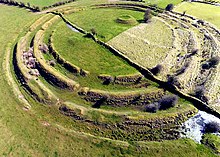Rath
In archeology , Ráth ( Irish ráth ; Ráthanna or lios ) denotes an Iron Age or older Irish earthwork . Ráths are often circular or oval ( called Ringfort in English ) and of different sizes. Diameters of 20 m are common, but like the Ráth excavated near Derry in Northern Ireland in 2005, they can also be 100 m wide and in individual cases also deviate to the square ( Ráth from Corliss ). They are also called "Fairy fort" (fairy castle), which indicates a religious meaning as Temene . The name can also be found in Wales where the Rudbaxton Rath and the " Walwyn's Castle Ráth " are located in Pembrokeshire .
description
A typical Ráth has a diameter of about 35 m and is surrounded by a four-meter-wide and two-meter-high earth wall with a ditch. A dam interrupts the ditch and leads to a gap in the wall. Since the Ráths were often built on weak slopes, the inner terrain often slopes down towards the entrance. Internal features may include basements and traces of houses visible as slight bumps. Around 280 of these ring forts were excavated in Ireland between 1930 and 2005.
Variants of the Ráth include systems with multiple walls and ditches ( Dunglady in County Londonderry , Lisnagade , Lisnavaragh in County Down , the three-walled and approximately 5.0 m high Ballinascaula in County Limerick ) and four-walled Rathrar or Rathbarna in County Roscommon as well a few with formal adaptations to the morphology of the landscape. Raths sometimes appear in groups or they touch each other. With this and with the multiple walls around them, they show properties that can also be observed in duns , henges and stone circles .
One of the variants has an interior trench that allows a one meter or less high platform to exist in the interior. Another variant is the sublime Rath, a hill up to four meters high inside. It was created as a kind of moth that is difficult to distinguish from the later Cambro-Norman complexes without excavation . Some Raths have the Anglicized designation "Fort" in their name. Tullaghoge Fort in County Tyrone is a council that was the inauguration place of the Cenél nEógain (the later O'Neills ) in the 11th century . This is where the O'Hagans resided , who carried out the inaugurations with the O'Cahans .
M. Stout published the dendrochronological data of 114 ring forts and some of the crannógs and basements connected with them . The first ring forts were built in the Bronze Age . The focus, however, is between 600 and 1000 AD. Its construction ends around 1300 AD. The dates for Crannógs are between 550 and 750 AD.
The Rath Laoghaire, the Rath of the Synods and the Rath Meave are the famous Raths of Tara .
Names
Similar to the Dun (e.g. in Dunguaire Castle ), the stone version of the Ráth, a number of Irish places have the term "Ráth" or the synonym "Lis" (Lisnagade Rath, Lisnavaragh Rath) as a prefix in the name:
- Northern Ireland
- Lisbane, County Down
- Lisbellaw, County Fermanagh
- Lisburn , County Antrim
- Lislea, County Armagh
- Lisnacree, County Down
- Lisnarrick, County Fermanagh
- Lisnaskea, County Fermanagh
- Rathkeltair, County Down
- Rathlin Island, County Antrim
- Rathmore, (Clogher) County Tyrone
- Rathmore, County Antrim
- Rathmullan Rath and Motte, County Down
- Rathtrillick, County Armagh
- Rathturret, County Down
- Republic of Ireland
- Liscannor , County Clare
- Liscarroll
- Lismore County Waterford
- Lispole, County Kerry
- Liselton, County Kerry
- Listowel , County Kerry
- Rathfran Monastery , County Mayo
- Ráth Cairn, County Meath
- Rathangan, County Kildare
- Rathbeagh , County Kilkenny
- Rathcoffey Castle, County Kildare
- Rathcroghan (the Council of Queen Medb ), County Roscommon
- Rathdrum, County Wicklow
- Rathgall , County Wicklow
- Rathkealy , County Kilkenny
- Rathkeale , County Limerick
- Rathmacknee Castle, County Wexford
- Rathmichael Church and Round Tower (Ireland) , County Dublin
- Rathmore , County Kerry
- Rathmore Church and High Cross County Meath
- Rathmore , County Kerry
- Rathmullan Monastery, County Donegal
- Rathsonny, County Galway
- Rathumney Castle, County Wexford
- Rathurles Church and Rath, County Tipperary
- also tautological duplication of "Li" and "Doon" (with Lisdoonvarna ) or "Caher" and "Doon" (Doon = Dun) (for Caherdooneerish ) occur.
literature
- M. Stout: The Irish ringfort . Dublin 2000, ISBN 1-85182-582-7 .
- Dep. of the Environment of Northern Ireland: Historic Monuments of Northern Ireland . Belfast 1987, ISBN 0-337-08180-8 .
Individual evidence
- ↑ During the 4th and 5th centuries, large groups of the Déisi moved from Ireland to Wales





